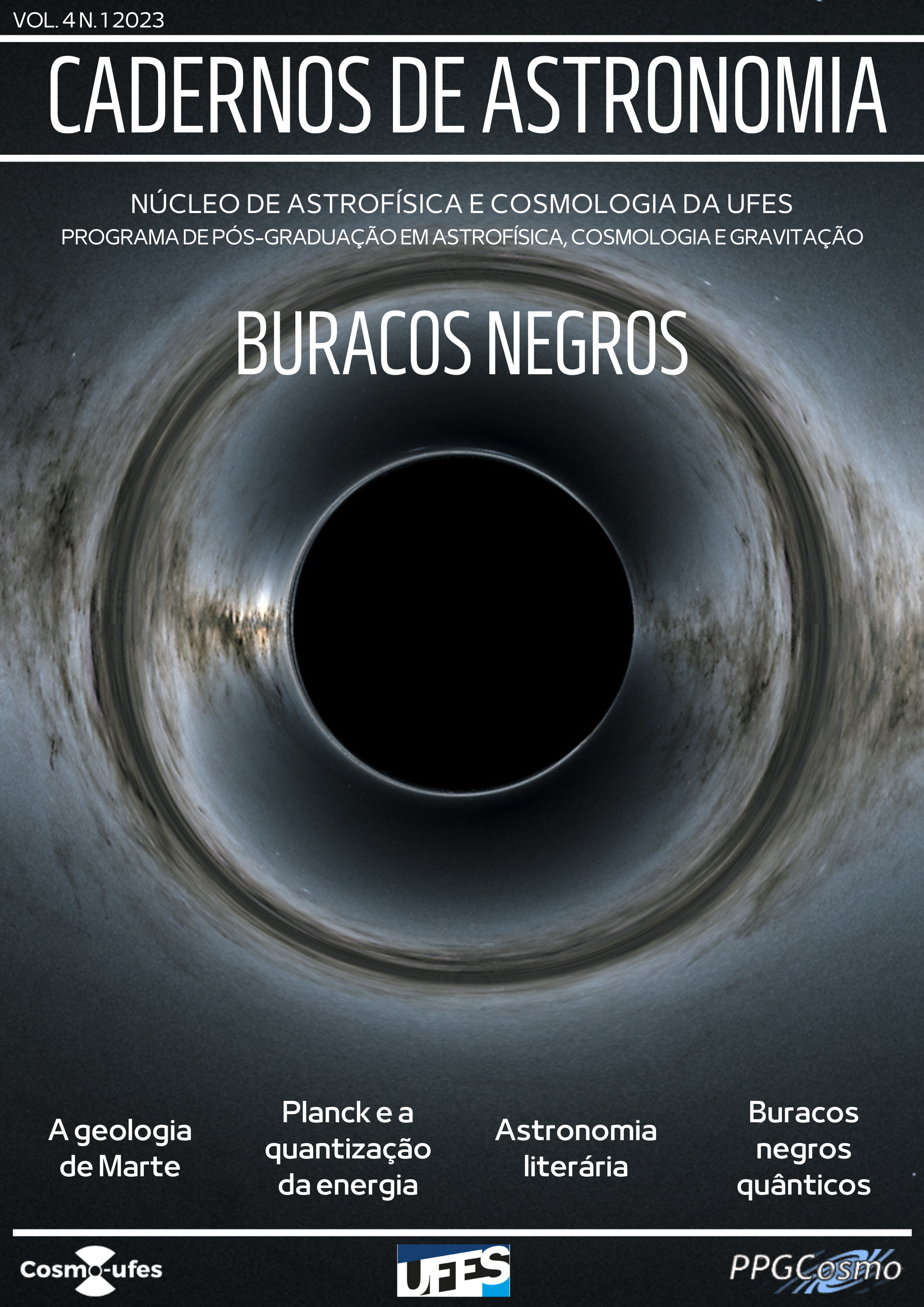A termodinâmica de buracos negros
DOI:
https://doi.org/10.47456/Cad.Astro.v4n1.39893Palavras-chave:
buracos negros, horizonte de eventos, termodinâmica, entropia, ensemble canônico, cavidadeResumo
Buracos negros existem em todo lado no nosso universo. Segundo a relatividade geral, estes objetos são clássicos e não emitem qualquer radiação, são negros. No entanto, quando se considera campos quânticos, verifica-se que os buracos negros são na realidade objetos termodinâmicos e que não são assim tão negros. Neste artigo, fazemos a exposição de como um buraco negro é termodinâmico. Primeiro, fazemos uma exposição breve da descrição clássica dos buracos negros e as suas quatro leis de mecânica. Depois, fazemos a exposição dos primeiros trabalhos que avançaram a ideia de que os buracos negros são termodinâmicos. Finalmente, fazemos a exposição do formalismo que permite tratar a termodinâmica de espaços-tempos contendo buracos negros e referimos muito brevemente a sua investigação recente.
Referências
C. W. Misner, K. S. Thorne e J. A. Wheeler, Gravitation (W. H. Freeman and Co., San Francisco, Calif., 1973).
GRAVITY Collaboration, Detection of the Schwarzschild precession in the orbit of the star S2 near the Galactic centre massive black hole, Astronomy & Astrophysics 636, L5 (2020).
EHT Collaboration, First M87 Event Horizon Telescope Results. I. The Shadow of the Supermassive Black Hole, The Astrophysical Journal 875(1), L1 (2019).
EHT Collaboration, First Sagittarius A* Event Horizon Telescope Results. I. The Shadow of the Supermassive Black Hole in the Center of the Milky Way, The Astrophysical Journal Letters 930(2), L12 (2022).
J. D. Bekenstein, Black holes and the second law, Lettere Al Nuovo Cimento Series 2 4(15), 737 (1972).
S. W. Hawking, Particle creation by black holes, Communications In Mathematical Physics 43(3), 199 (1975).
J. Wheeler e K. Ford, Geons, Black Holes and Quantum Foam: A Life in Physics (Norton, New York, 2000).
H. R. Buchdahl, General relativistic fluid spheres, Physical Review 116(4), 1027 (1959).
J. Oppenheimer e H. Snyder, On continued gravitational contraction, Physical Review 56(5), 455 (1939).
M. Begelman, M. Volonteri e M. Rees, Formation of supermassive black holes by direct collapse in pre-galactic haloes, Monthly Notices of the Royal Astronomical Society 370(1), 289 (2006).
L. Boco et al., Growth of massive black hole seeds by migration of stellar and primordial black holes: gravitational waves and stochastic background, Journal of Cosmology and Astroparticle Physics 2021(10), 035 (2021).
B. Carter, Axisymmetric black hole has only two degrees of freedom, Physical Review Letters 26(6), 331 (1971).
J. M. Bardeen, B. Carter e S. W. Hawking, The four laws of black hole mechanics, Communications in Mathematical Physics 31(2), 161 (1973).
S. W. Hawking, Black holes in general relativity, Communications in Mathematical Physics 25(2), 152 (1972).
R. Penrose, Gravitational collapse: The role of general relativity, Riv. Nuovo Cim. 1, 257 (1969), republicado em R. Penrose, “Golden Oldie”: Gravitational Collapse: The Role of General Relativity, General Relativity and Gravitation 34, 1141 (2002).
R. M. Wald, Quantum Field Theory in Curved Spacetime and Black Hole Thermodynamics (University of Chicago, Chicago, 1994).
S. Fulling, Nonuniqueness of canonical field quantization in Riemannian space-time, Physical Review D 7(10), 2850 (1973).
P. C. W. Davies, Scalar production in Schwarzschild and Rindler metrics, Journal of Physics A: Mathematical and General 8(4), 609 (1975).
W. Unruh, Notes on black-hole evaporation, Physical Review D 14(4), 870 (1976).
G. Gibbons e S. Hawking, Action integrals and partition functions in quantum gravity, Physical Review D 15(10), 2752 (1977).
J. York, Black-hole thermodynamics and the Euclidean Einstein action, Physical Review D 33(8), 2092 (1986).
H. Braden et al., Charged black hole in a grand canonical ensemble, Physical Review D 42(10), 3376 (1990).
C. Peça e J. Lemos, Thermodynamics of Reissner–Nordström–anti-de Sitter black holes in the grand canonical ensemble, Physical Review D 59(12), 124007 (1999).
M. Akbar, Schwarzschild–anti-de Sitter black holes within isothermal cavity: Thermodynamics, phase transitions, and the Dirichlet problem, Physical Review D 82(6), 064001 (2010).
O. Zaslavskii, Canonical ensemble for arbitrary configurations of self-gravitating systems, Physics Letters A 152(9), 463 (1990).
E. Martinez e J. York, Additivity of the entropies of black holes and matter in equilibrium, Physical Review D 40(6), 2124 (1989).
R. André e J. Lemos, Thermodynamics of five-dimensional Schwarzschild black holes in the canonical ensemble, Physical Review D 102(2), 024006 (2020).
R. André e J. Lemos, Thermodynamics of ddimensional Schwarzschild black holes in the canonical ensemble, Physical Review D 103, 064069 (2021).
T. Fernandes e J. Lemos, Electrically charged spherical matter shells in higher dimensions: Entropy, thermodynamic stability, and the black hole limit, Physical Review D 106(10), 104008 (2022).
J. Fernandes e J. P. S. Lemos, Grand canonical ensemble of a d-dimensional ReissnerNordström spacetime in a cavity, a ser publicado.
Downloads
Publicado
Edição
Seção
Licença
Copyright (c) 2023 Tiago Fernandes

Este trabalho está licenciado sob uma licença Creative Commons Attribution 4.0 International License.






